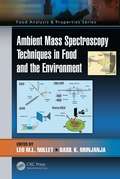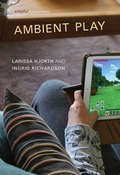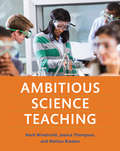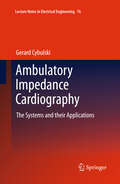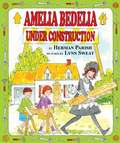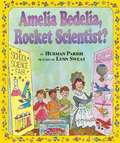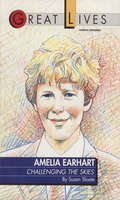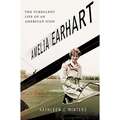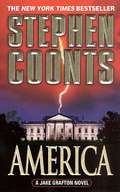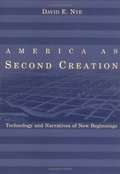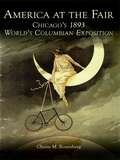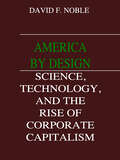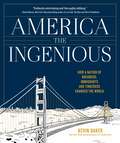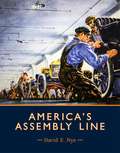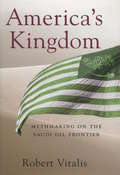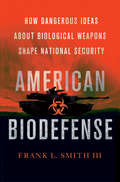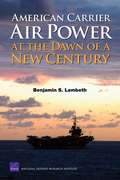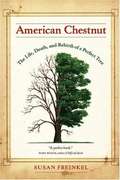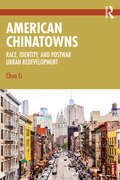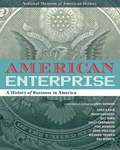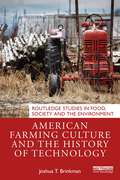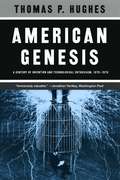- Table View
- List View
Ambient Mass Spectroscopy Techniques in Food and the Environment (Food Analysis & Properties)
by Leo M.L. Nollet Basil K. MunjanjaAmbient mass spectrometry—that is the use of mass spec but in the atmospheric environment—has been widely employed in food and environmental analysis. Ambient Mass Spectroscopy Techniques in Food and the Environment presents the theoretical underpinnings of mass spectrometry, and the benefits and pitfalls of ambient mass spectrometry, as well as the latest developments of the technique, in the analysis of food and environmental parameters. It describes methods that enable the detection of surface materials like waxes, alkaloids, flavors, or pesticides by plainly exposing the corresponding items to the ionization region of the interface, without harm to samples. Features: Explains the theoretical aspects of ambient mass spectrometry Describes how to use ambient MS techniques for food safety, authenticity, and traceability screening Lists the benefits of ambient MS in analysis of food and environmental parameters Covers recent developments of ambient MS in analysis of food and environmental parameters The specialized work provides insight to professionals practicing in food and the environment, including food scientists, food engineers, food biotechnologists, chemical engineers, and those working in research labs, universities, and government regulatory agencies.
Ambient Play (Playful Thinking)
by Larissa Hjorth Ingrid RichardsonAn engaging look at how mobile games are increasingly part of our day-to-day lives and the ways that we interact across real as well as digital landscapes.We often play games on our mobile devices when we have some time to kill--waiting in line, pausing between tasks, stuck on a bus. We play in solitude or in company, alone in a bedroom or with others in the family room. In Ambient Play, Larissa Hjorth and Ingrid Richardson examine how mobile gameplay fits into our day-to-day lives. They show that as mobile games spread across different genres, platforms, practices, and contexts, they become an important way of experiencing and navigating a digitally saturated world. We are digital wayfarers, moving constantly among digital, social, and social worlds.
Ambisonics: A Practical 3D Audio Theory for Recording, Studio Production, Sound Reinforcement, and Virtual Reality (Springer Topics in Signal Processing #19)
by Franz Zotter Matthias FrankThis open access book provides a concise explanation of the fundamentals and background of the surround sound recording and playback technology Ambisonics. It equips readers with the psychoacoustical, signal processing, acoustical, and mathematical knowledge needed to understand the inner workings of modern processing utilities, special equipment for recording, manipulation, and reproduction in the higher-order Ambisonic format. The book comes with various practical examples based on free software tools and open scientific data for reproducible research.The book’s introductory section offers a perspective on Ambisonics spanning from the origins of coincident recordings in the 1930s to the Ambisonic concepts of the 1970s, as well as classical ways of applying Ambisonics in first-order coincident sound scene recording and reproduction that have been practiced since the 1980s. As, from time to time, the underlying mathematics become quite involved, but should be comprehensive without sacrificing readability, the book includes an extensive mathematical appendix. The book offers readers a deeper understanding of Ambisonic technologies, and will especially benefit scientists, audio-system and audio-recording engineers.In the advanced sections of the book, fundamentals and modern techniques as higher-order Ambisonic decoding, 3D audio effects, and higher-order recording are explained. Those techniques are shown to be suitable to supply audience areas ranging from studio-sized to hundreds of listeners, or headphone-based playback, regardless whether it is live, interactive, or studio-produced 3D audio material.
Ambitious Science Teaching
by Jessica Thompson Mark Windschitl Melissa Braaten2018 Outstanding Academic Title, ChoiceAmbitious Science Teaching outlines a powerful framework for science teaching to ensure that instruction is rigorous and equitable for students from all backgrounds. The practices presented in the book are being used in schools and districts that seek to improve science teaching at scale, and a wide range of science subjects and grade levels are represented. The book is organized around four sets of core teaching practices: planning for engagement with big ideas; eliciting student thinking; supporting changes in students&’ thinking; and drawing together evidence-based explanations. Discussion of each practice includes tools and routines that teachers can use to support students&’ participation, transcripts of actual student-teacher dialogue and descriptions of teachers&’ thinking as it unfolds, and examples of student work. The book also provides explicit guidance for &“opportunity to learn&” strategies that can help scaffold the participation of diverse students. Since the success of these practices depends so heavily on discourse among students, Ambitious Science Teaching includes chapters on productive classroom talk. Science-specific skills such as modeling and scientific argument are also covered. Drawing on the emerging research on core teaching practices and their extensive work with preservice and in-service teachers, Ambitious Science Teaching presents a coherent and aligned set of resources for educators striving to meet the considerable challenges that have been set for them.
Ambulatory Impedance Cardiography: The Systems and their Applications (Lecture Notes in Electrical Engineering #76)
by Gerard CybulskiThe book is divided in 4 parts. In the first one, the importance of the analysis of the cardiac dynamics using the ambulatory monitoring technique is presented. The second part contains the description of foundations of impedance cardiography (ICG), the models used to describe the ICG technique and the description of available systems for ambulatory monitoring of cardiac hemodynamics. The third part is devoted to the validation of the ambulatory ICG method, the verification of the quality of long term ICG recordings and the discussion of the limitations of this technique. In the last part, some clinical and research applications of the ICG ambulatory monitoring are presented. The simultaneous recordings of electrocardiogram (ECG) and ICG in the transient cardiac arrhythmia events illustrate the potential applications of that method for quantitative analysis of hemodynamics when the implementation of the stationary methods would be either difficult or not possible to do. The book is followed by references, alphabetical index and appendices containing the technical data of the available systems for portable monitoring of cardiac hemodynamics.
Amelia Bedelia Under Construction (I Can Read! #22)
by Herman ParishWhen Amelia Bedelia babysits for the Hardy family, she become involved in some unexpected remodeling of their house.
Amelia Bedelia, Rocket Scientist
by Herman ParishHousekeeper Amelia Bedelia wreaks havoc when she volunteers to help out at the school science fair.
Amelia Earhart
by Susan SloateThe Great Lives SeriesWitness history in the making as you turn the pages of time and discover the fascinating lives of famous explorers, leaders of 20th century politics and government, and great Americans.Amelia EarhartChallenging the SkiesWhen Amelia Earhart vanished over the Pacific Ocean in 1937 during her attempt to make the first round-the-world flight via the equator, it sparked one of the century's greatest mysteries. Did she crash? Was she taken prisoner by the Japanese? Was she on a spying mission for the U.S government? Is she alive today?The First Woman To Fly Across the Atlantic!Amelia Earhart: Challenging the Skies is the story of a compelling woman whose achievements spurred the growth of commercial aviation and furthered the cause of women's rights, as well. Accompany Amelia into the dangerous skies of the first days of flight and watch as she tames them with a daring all her own!The Great Lives Series has been developed under the auspices of Dr. Frank Moretti, Ph.D., Associate Headmaster of The Dalton School in New York City; Dr. Paul Mattingly, Ph.D., Professor of History at New York University; and Barbara Smith, M.S., Assistant Superintendent of the Los Angeles Unified School District.From the Trade Paperback edition.
Amelia Earhart: The Turbulent Life of an American Icon
by Kathleen C. WintersWhen Amelia Earhart disappeared over the Pacific in 1937, she was at the height of her fame. Fascination with Earhart remains just as strong today, as her mysterious disappearance continues to inspire speculation. In this nuanced and often surprising biography, acclaimed aviation historian Kathleen C. Winters moves beyond the caricature of the spunky, precocious pilot to offer a more complex portrait. Drawing on a wealth of contemporary accounts, airline records, and other original research, this book reveals a flawed heroine who was frequently reckless and lacked basic navigation skills, but who was also a canny manipulator of mass media. Winters details how Earhart and her husband, publisher George Putnam, worked to establish her as an international icon, even as other spectacular pilots went unnoticed. Sympathetic yet unsentimental, this biography helps us to see Amelia Earhart with fresh eyes.
America (Jake Grafton #9)
by Stephen CoontsDispatched on a trial run, NASA's SuperAegis satellite has been created as the foundation of an international antimissile defense system. But moments after dispatch, it vanishes.
America as Second Creation: Technology and Narratives of New Beginnings
by David E. NyeAfter 1776, the former American colonies began to reimagine themselves as a unified, self-created community. Technologies had an important role in the resulting national narratives, and a few technologies assumed particular prominence. Among these were the axe, the mill, the canal, the railroad, and the irrigation dam. In this book David Nye explores the stories that clustered around these technologies. In doing so, he rediscovers an American story of origins, with America conceived as a second creation built in harmony with God's first creation. While mainstream Americans constructed technological foundation stories to explain their place in the New World, however, marginalized groups told other stories of destruction and loss. Native Americans protested the loss of their forests, fishermen resisted the construction of dams, and early environmentalists feared the exhaustionof resources. A water mill could be viewed as the kernel of a new community or as a new way to exploit labor. If passengers comprehended railways as part of a larger narrative about American expansion and progress, many farmers attacked railroad land grants. To explore these contradictions, Nye devotes alternating chapters to narratives of second creation and to narratives of those who rejected it. Nye draws on popular literature, speeches, advertisements, paintings, and many other media to create a history of American foundation stories. He shows how these stories were revised periodically, as social and economic conditions changed, without ever erasing the earlier stories entirely. The image of the isolated frontier family carving a homestead out of the wilderness with an axe persists to this day, alongside later images and narratives. In the book's conclusion, Nye considers the relation between these earlier stories and such later American developments as the conservation movement, narratives of environmental recovery, and the idealization of wilderness.
America at the Fair: Chicago's 1893 World's Columbian Exposition
by Chaim M. RosenbergAt the time of the World's Columbian Exposition of 1893, the United States was fast becoming the world's leading economy. Chicago, the host city, had grown in less than half a century from a village to the country's second-largest metropolis. During this, the Gilded Age, the world's most extensive railroad and steamship networks poured ceaselessly through Chicago, carrying the raw goods and finished products of America's great age of invention and industrial expansion. The Fair was the largest ever at the time, with 65,000 exhibitors and millions of visitors. It has been called the "Blueprint of the American Future" and marked the beginning of the national economy and consumer culture.
America the Ingenious: How a Nation of Dreamers, Immigrants, and Tinkerers Changed the World
by Kevin Baker“Among the many rewards of America the Ingenious, Kevin Baker’s survey of Yankee know-how, is stumbling on its buried nuggets. . . . Baker examines a wide range of the achievements that have made, and still make, America great again—and again.” —The Wall Street Journal All made in America: The skyscraper and subway car. The telephone and telegraph. The safety elevator and safety pin. Plus the microprocessor, amusement park, MRI, supermarket, Pennsylvania rifle, and Tennessee Valley Authority. Not to mention the city of Chicago or jazz or that magnificent Golden Gate Bridge. What is it about America that makes it a nation of inventors, tinkerers, researchers, and adventurers—obsessive pursuers of the never-before-created? And, equally, what is it that makes America such a fertile place to explore, discover, and launch the next big thing? In America the Ingenious, bestselling author Kevin Baker brings his gift of storytelling and eye for historical detail to the grand, and grandly entertaining, tale of American innovation. Here are the Edisons and Bells and Carnegies, and the stories of how they followed their passions and changed our world. And also the less celebrated, like Jacob Youphes and Loeb Strauss, two Jewish immigrants from Germany who transformed the way at least half the world now dresses (hint: Levi Strauss). And Leo Fender, who couldn’t play a note of music, midwifing rock ’n’ roll through his solid-body electric guitar and amplifier. And the many women who weren’t legally recognized as inventors, but who created things to make their lives easier that we use every day—like Josephine Cochran, inventor of the dishwasher, or Marion O’Brien Donovan, who invented a waterproof diaper cover. Or a guy with the improbable name of Philo Farnsworth, who, with his invention of television, upended communication as significantly as Gutenberg did. At a time when America struggles with different visions of what it wants to be, America the Ingenious shows the extraordinary power of what works: how immigration leads to innovation, what a strong government and strong public education mean to a climate of positive practical change, and why taking the long view instead of looking for short-term gain pays off many times over, not only for investors and inventors, but for the rest of us whose lives are made better by the new. America and its nation of immigrants have excelled at taking ideas from anywhere and transforming them into the startling, often unexpectedly beautiful creations that have shaped our world. This is that story.
America's Assembly Line
by David E. NyeThe assembly line was invented in 1913 and has been in continuous operation eversince. It is the most familiar form of mass production. Both praised as a boon to workers andcondemned for exploiting them, it has been celebrated and satirized. (We can still picture Chaplin'slittle tramp trying to keep up with a factory conveyor belt. ) In America's AssemblyLine, David Nye examines the industrial innovation that made the United States productiveand wealthy in the twentieth century. The assembly line -- developed at the FordMotor Company in 1913 for the mass production of Model Ts -- first created and then served anexpanding mass market. It inspired fiction, paintings, photographs, comedy, cafeteria layouts, andcookie-cutter suburban housing. It also transformed industrial labor and provoked strikes and uniondrives. During World War II and the Cold War, it was often seen as a bastion of liberty andcapitalism. By 1980, Japan had reinvented the assembly line as a system of "leanmanufacturing"; American industry reluctantly adopted this new approach. Nye describes thisevolution and the new global landscape of increasingly automated factories, with fewer industrialjobs in America and questionable working conditions in developing countries. A century after Ford'spioneering innovation, the assembly line continues to evolve toward more sustainablemanufacturing.
America's Kingdom: Mythmaking on the Saudi Oil Frontier
by Robert VitalisIn telling the story of the Arabian American Oil Company (ARAMCO) in Saudi Arabia, Vitalis takes aim at a number of myths of exceptionalism he finds common to earlier narratives such as the PBS documentary "The Prize" and Thomas Lippman's "Inside the Mirage". These include the idea that ARAMCO was less exploitive than, say, mining companies in Africa and the idea that Saudi Arabia developed in relative international isolation and represents a relatively unique case in the history of extractive economies. His discussion looks at how ARAMCO officials set up a system of social hierarchy similar to Jim Crow or Apartheid in the oil town of Dhahran, explores the Saudi workers' challenges to this system of hierarchy and to their economic exploitation, and parallel challenges to the international oil hierarchy represented by ARAMCO from progressive state-building forces in the Saudi government.
American Biodefense: How Dangerous Ideas about Biological Weapons Shape National Security
by Frank L. Smith IIIBiological weapons have threatened U.S. national security since at least World War II. Historically, however, the U.S. military has neglected research, development, acquisition, and doctrine for biodefense. Following September 11 and the anthrax letters of 2001, the United States started spending billions of dollars per year on medical countermeasures and biological detection systems. But most of this funding now comes from the Department of Health and Human Services rather than the Department of Defense. Why has the U.S. military neglected biodefense and allowed civilian organizations to take the lead in defending the country against biological attacks? In American Biodefense, Frank L. Smith III addresses this puzzling and largely untold story about science, technology, and national security. Smith argues that organizational frames and stereotypes have caused both military neglect and the rise of civilian biodefense. In the armed services, influential ideas about kinetic warfare have undermined defense against biological warfare. The influence of these ideas on science and technology challenges the conventional wisdom that national security policy is driven by threats or bureaucratic interests. Given the ideas at work inside the U.S. military, Smith explains how the lessons learned from biodefense can help solve other important problems that range from radiation weapons to cyber attacks.
American Boundaries: The Nation, The States, The Rectangular Survey
by Bill Hubbard Jr.For anyone who has looked at a map of the United States and wondered how Texas and Oklahoma got their Panhandles, or flown over the American heartland and marveled at the vast grid spreading out in all directions below, American Boundaries will yield a welcome treasure trove of insight. The first book to chart the country's growth using the boundary as a political and cultural focus, Bill Hubbard's masterly narrative begins by explaining how the original thirteen colonies organized their borders and decided that unsettled lands should be held in trust for the common benefit of the people. Hubbard goes on to show--with the help of photographs, diagrams, and hundreds of maps--how the notion evolved that unsettled land should be divided into rectangles and sold to individual farmers, and how this rectangular survey spread outward from its origins in Ohio, with surveyors drawing straight lines across the face of the continent. Mapping how each state came to have its current shape, and how the nation itself formed within its present borders, American Boundaries will provide historians, geographers, and general readers alike with the fascinating story behind those fifty distinctive jigsaw-puzzle pieces that together form the United States.
American Carrier Air Power at the Dawn of a New Century
by Benjamin S. LambethIn the Afghanistan war, U.S. carrier-based fighters substituted almost entirely for land-based theater air forces. The Navy's carriers again played a key role in conducting around-the-clock operations against Saddam Hussein's forces in Iraq. American carrier air power is now able to conduct coordinated deep-strike missions well beyond coastal reaches. The Navy's performance over Afghanistan and Iraq showed how the nation's carrier force can provide around-the-clock target coverage, consistently accurate target attack, and multiple successful target attacks per sortie.
American Chestnut: The Life, Death, and Rebirth of a Perfect Tree
by Susan FreinkelThe American chestnut was one of America's most common, valued, and beloved trees. Susan Freinkel tells the dramatic story of the stubborn optimists who refused to let this cultural icon go. In a compelling weave of history, science, and personal observation, she relates their quest to save the tree through methods that ranged from classical plant breeding to cutting-edge gene technology.
American Chinatowns: Race, Identity, and Postwar Urban Redevelopment
by Chuo LiAmerican Chinatowns: Race, Identity, and Postwar Urban Redevelopment offers a captivating exploration of the vibrant yet contested landscapes of Chinatowns across the United States.Through a critical and nuanced lens, Li examines how postwar urban redevelopment, racial dynamics, and identity politics have profoundly transformed these iconic neighborhoods. Blending rich historical research with sharp analysis, this book uncovers the interplay of race, urban planning ideologies, and social equity, shedding light on how Chinatowns navigate resilience and reinvention amid shifting urban paradigms. Li’s work highlights the tension between cultural preservation and modernization, exploring the built environment alongside community-driven spatial activism to reveal how these urban spaces persist as sites of resistance, identity, and transformation. American Chinatowns is a compelling study of cultural landscape, urban justice, and the politics of city-making.This book is essential reading for scholars, urbanists, and anyone intrigued by the intersection of race, identity, and the evolving narratives of America’s cities. This book invites readers to rethink the meaning of place, heritage, and equity in the urban fabric.
American Congo: The African American Freedom Struggle in the Delta
by Nan Elizabeth WoodruffIn 1921, freedom fighter William Pickens described the Mississippi River Valley as the "American Congo. " Nan Woodruff argues that the African Congo under Belgium's King Leopold II is an apt metaphor for the Delta of the early twentieth century. Both wore the face of science, progressivism, and benevolence, yet were underwritten by brutal labor conditions, violence, and terror. As in the Congo, she argues, the Delta began with the promise of empire: U. S. capitalists on the lookout for new prospects cleared the vast Delta swamps. With the subsequent emergence of a wealthy planter class, the promise of untold riches, and a largely black labor force, America had its Congo. Woodruff chronicles the following half-century of individual and collective struggles as black sharecroppers fought to earn a just return for their labor, to live free from terror, to own property, to have equal access to the legal system, to move at will, and to vote. They fought for citizenship not only of men, but of women and families, and were empowered by the wars and upheavals of the time. Indeed, Woodruff argues, the civil rights movement cannot be adequately understood apart from these earlier battles for freedom.
American Enterprise
by Nancy Davis Andy Serwer David Allison Peter Liebhold Kathleen G. FranzWhat does it mean to be an American? What are American ideas and values? American Enterprise, the companion book to a major exhibition at the Smithsonian's National Museum of American History, aims to answer these questions about the American experience through an exploration of its economic and commercial history. It argues that by looking at the intersection of capitalism and democracy, we can see where we as a nation have come from and where we might be going in the future.Richly illustrated with images of objects from the museum's collections, American Enterprise includes a 1794 dollar coin, Alexander Graham Bell's 1876 telephone, a brass cash register from Marshall Fields, Sam Walton's cap, and many other goods and services that have shaped American culture. Historical and contemporary advertisements are also featured, emphasizing the evolution of the relationship between producers and consumers over time. Interspersed in the historical narrative are essays from today's industry leaders--including Sheila Bair, Adam Davidson, Bill Ford, Sally Greenberg, Fisk Johnson, Hank Paulson, Richard Trumka, and Pat Woertz--that pose provocative questions about the state of contemporary American business and society. American Enterprise is a multi-faceted survey of the nation's business heritage and corresponding social effects that is fundamental to an understanding of the lives of the American people, the history of the United States, and the nation's role in global affairs.
American Farming Culture and the History of Technology (Routledge Studies in Food, Society and the Environment)
by Joshua T. BrinkmanPresenting a history of agriculture in the American Corn Belt, this book argues that modernization occurred not only for economic reasons but also because of how farmers use technology as a part of their identity and culture.Histories of agriculture often fail to give agency to farmers in bringing about change and ignore how people embed technology with social meaning. This book, however, shows how farmers use technology to express their identities in unspoken ways and provides a framework for bridging the current rural-urban divide by presenting a fresh perspective on rural cultural practices. Focusing on German and Jeffersonian farmers in the 18th century and Corn Belt producers in the 1920s, the Cold War, and the recent period of globalization, this book traces how farmers formed their own versions of rural modernity. Rural people use technology to contest urban modernity and debunk yokel stereotypes and women specifically employed technology to resist urban gender conceptions. This book shows how this performance of rural identity through technological use impacts a variety of current policy issues and business interests surrounding contemporary agriculture from the controversy over genetically modified organisms and hog confinement facilities to the growth of wind energy and precision technologies. Inspired by the author's own experience on his family’s farm, this book provides a novel and important approach to understanding how farmers’ culture has changed over time, and why machinery is such a potent part of their identity.This book will be of great interest to students and scholars of agricultural history, technology and policy, rural studies, the history of science and technology, and the history of farming culture in the USA.
